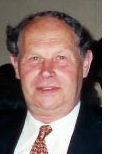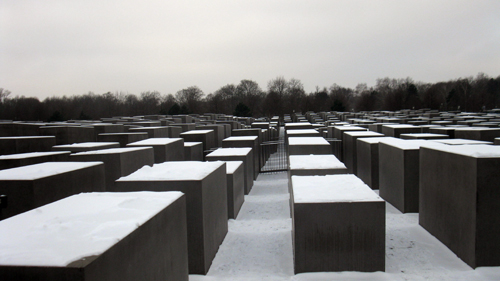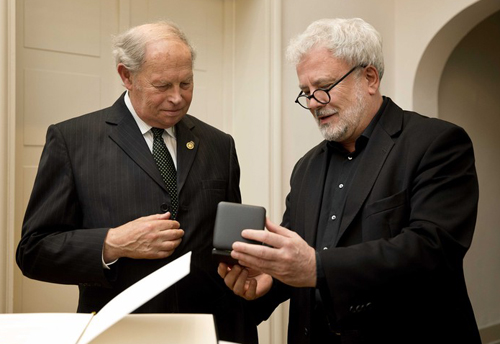Editor’s Note: Holocaust Survivor Garry Fabian, on the invitation of several German Foundations, recently returned to his native Stuttgart and other German cities from Australia, where he took refuge after liberation from Theresienstadt. Fabian kept a journal on the trip, excerpts from which we reprint here.
By Garry Fabian

21-22 January
Departed Melbourne at 10.30pm on Emirates Airways, arriving in Dubai some 14 hours later. After a three hour stop-over the next leg to Frankfurt took seven hours. Arriving in Frankfurt after some asking (and there seem to be a range of Sergeant Schmitt’s (of old TV series Hogan’s Heroes) -” I know nothing” – around there. It is lucky I speak German) found my way to the Haupt Bahnhof and located the right train to Braunschweig.
The trip on the long distance train (ICE) to Braunschweig took two and a half hours. Arriving there I was met on the platform by Herbert, Alice and Malte, which was a most welcoming experience. They live in a nearby town, Schoppenstadt, about a 15 minute drive from Braunschweig, and I settled in, after overcoming the shock of minus 11 degrees and snow all over the streets.
23 January
Was awakened early 6.30am for a trip to Berlin, about a two hour drive. Herbert had some business to transact there, and the visit to Berlin was a most unexpected bonus. Alice and Malte took me to the Holocaust museum. The stone pillars were covered with snow, which provided an additional solemn aura. The museum itself, located underground is quite stark with panels of copies of letters as well as panels depicting stories of different families.

Then we drove through the streets of Berlin, including the length of Kurfursten Dam, stopping for lunch, the first of many meals I was treated to during my visit.
In the late afternoon went to the Technical University of Braunschweig, who were the major sponsors of my trip for two events. The first was a press conference with radio, TV and newspapers, lasting about one hour.
This was followed speaking to an audience of around 80 – 90, mostly students, staff members and other interested people, followed by a range of questions. This was all conducted in German, with the help of Malte, who acted as my back-up dictionary when I was stuck for a German word…
At the conclusion of the meeting returned home to the Scheibe household for a very pleasant and gemutlich evening. Their friendly hospitality is really marvelous, and after just 24 hours there, I feel part of the family.
24 January
This morning we visited a Secondary School, and I spoke to an audience of around 600 students, once again a range of varied and probing questions, which hopefully I provided answers to. By the general reaction I believe it was successful, onnce again Malte being my dictionary and ears
There were articles almost every day about my addresses. If fact there was press coverage every day for the five days in Braunschweig – quite amazing. As Andy Warhol said Everyone is entitled in 15 minutes of fame but I certainly got a lot more than 15 minutes
In the evening another meeting to an older audience at the local SPD (Socialist Party of Germany) in his introduction Herbert mentioned that (Australian) Senator Kim Carr (another good Socialist) is my son-in-law.
While it only the third day of my visit, it is turning out to be a quite extraordinary experience. On the one hand it feels alien – perhaps the contrast in the weather coming from a 40+ degrees of a Melbourne summer to a minus 11 degree winter is a factor. On the other hand it is familiar and I feel quite connected.
It is almost as if the two hemispheres of my life, past and present have found a common presence. Combining the distant past of my childhood with my adult life, creating a Germany-Australia bond across language and culture.
Later in the day, spoke to a group of about 40 -50 organized by the mayor of Schoningen, a nearby town, to a more mature audience. I spoke about the story of my family, dating back to the 13 hundreds in Germany and my experiences during the period 1934 – 1945. Also describing the physical layout of Theresienstadt and life in the Ghetto, as well as my own experiences. This session last for about one-and-a-half hours, and once again I believe it went well. At the end of the presentation I was invited to sign The Golden Visitors Book reserved for VIP visitors to the town.
I try to tailor my presentation to each audience allowing for different age groups and their questions. Noted that with each presentation it gets more fluid and also my German definitely improves and less English words tend to creep in.
25 January
This morning was my turn to be a spectator. Herbert is a keen cyclist and is head of a cycling and athletics club with some 1000 members. We went to the club premises to watch the younger members train (no not cycling out on the snow, just exercising indoors). After lunch went back to Braunschweig to give a brief Gruessword (short greetings) at a function at a place of Remembrance on the site of a former slave labour camp based on my Theresienstadt experiences. The main speaker at the function was an academic giving a paper on German soldiers during the war how they perceived their role, based on letters they sent home from the front.
I must say he scratched some scabs for me. Cleary their attitude towards the enemy in the east was formed by decades of Nazi indoctrination about the Untermenschen (sub humans) and their unwavering personal loyalty to The Fuehrer. While the paper did acknowledge the fact when the war started going badly, they still maintained that their part in the war was a just one in the defense of the Fatherland, and no acknowledgement to the fact that Germany started the war in the first place. Perhaps I misinterpreted the paper, but later discussing it with Herbert, he expressed the same opinion, and felt the paper was very one sided and did not present an alternative balanced view.
That evening another surprise packet. The Cycling and Athletics club held their annual Ball, which took place in the local castle, and was quite an impressive function. I was welcomed as a special honoured guest. There was a dance display – a bit like Dancing with the Stars – a group of girl Cheer Leaders giving athletics display and lots of dancing and drinks all round.
Quite a number of people came up to me during the evening to talk, either because they had heard me at one of the functions or had read about me in the paper. As they say “Sic Transit Gloria” (and for those not familiar with Latin – no it does not mean Gloria was seasick).
26 January
Today being Sunday it was “ A Rest Day” for me. We drove Wolfsburg the home of VW, and Autostatd, which is the VW Complex, and quite an amazing seemingly endless place. There is an Auto Museum with displays stretching over four floors, plus a range of other attractions, including a section where you can design your own car on a computer screen, a range of restaurants, just to scratch the surface. The complex employs some 65,000. It would take a full week to see only a part of it in detail.
On the way home, we stopped in Braunschweig at the Jewish Museum, which oddly enough is housed in an old Monastery. There are no Jews living in the city today. The displays explain the history of the now vanished community in a series of informative panels, and also has a partial recreation of a synagogue which has been rescued from another town in the area. All in all it was a most interesting day. Combining modern technology and the story of a vanished segment of the community.
27 January
Today was International Holocaust Remembrance Day, and here in Germany flags on all official buildings are flown at half-mast, with ceremonies held in all towns large and small.
Today I spoke to some 350 students at the Schoppenstadt High School, and once again was very well received with many questions. This was followed by a wreath laying ceremony at a site of a former Jewish cemetery, opposite the school. While the cemetery no longer exists having been obliterated during the war, a plaque indicated that it existed in the past on that spot.
The School principal, Mr Kluge spoke at the wreath laying ceremony, stressing that the site should serve as a daily reminder of the atrocities of the Nazi era, and students passing the site every day to and from school must ensure that it can never happen again in the future.
An interesting side light was that an Australian exchange student is at the school, and we had a long chat.
In the evening a function was arranged by the major of Schoppenstadt, Ruth Naumann. Initially the function was planned for the local Rathaus (town hall for all non German-speaking droogs) but was shifted to the Til Eulenspiegel museum which is much larger, as the bookings exceeded their expectation.
(For those familiar with German fairytales the town was the home of Til Eulenspiegel, a legendary figure in German folk lore) The hall was full with some 150 in attendance across a wide range of ages. Again as on all other occasions a wide range of questions were asked. After the function I was invited to sigh the VIP visitors book, – getting to be quite a habit by now.
Another interesting thing happened. A local author who has written a book with a series of poems, some referring to the fate of Jewish members of the population asked me to write a dedication in his book.
28 January
Today it was fond farewell to pleasant but cold Braunschweig, and the extremely hospitable Scheibe family, who I have become very fond of. An interesting statistic that Herbert assembled in writing the report to the various foundations was that during the six meetings in Braunschweig I address around 1000 people.
Now off to Stuttgart for the next segment of the program. A relaxing four-hour train trip on the very comfortable train. Arriving in Stuttgart I was met by our old fried Joachim Auch on the platform, a most welcoming sight that made it feel like a homecoming. He drove me to my hotel, where Michael Kinzle was there to greet me, strengthening the feeling of the homecoming. After the “mandatory” Kaffe und Kuchen, Jupp Klegraf who heads the Zeichen der Erinerung, the organization that organized the Memorial Wall at the railway station and is now actively promoting the Stolpersteine project, met me and took me to the memorial site. We also visited the Gedenkenstette at Killesberg, where the deportation transports were assembled.
In the evening Joachim picked me up and we drove to his house, located some 15 minutes outside the city for dinner with Claudia and Joachim’s mother Ruth. It was a very pleasant and relaxing evening, away from crowds and speaking engagements, recalling our previous two visits.
29 January
This morning off to speak to 60 students at Anne-Frank High School, where there were many questions which indicated that the study of the Holocaust was quite in depth, which would seem logical considering the name of the school.
The rest of the day there were no formal commitments and the weather was quite mild plus 3 degrees, which after the days of freezing temperatures in Braunschweig was welcome. I took a long walk the full length Konigstrasse about one km each way, which not only gave me a chance for a bit of exercise but also much needed solitude to unwind. I even treated myself to a hot chocolate and cake – following the good German tradition.
30 January
This morning another absorbing meeting with some 25 trainee teachers at a teachers college in Ludwigsburg, a Stuttgart suburb. We had a very lively discussion both about my talk and also the propaganda film Der Fuehrer Schenk den Juden Eine Stadt, which we viewed. On the lighter side, I was presented with a bottle of wine with a specially designed label, commemorating my visit.
The next stop was at the Stadt Jugend Ring, a roof organization for around 90 youth clubs in Baden Wurtenberg. There I was interviewed and filmed as part of their project of a series of survivor documentary testitmony’s, the session lasting over one hour.
Again as on previous days there was press coverage in at least two newspapers.
In the evening something occurred that was quite unexpected and overwhelming. To describe it as “the icing on the cake” does not do it justice. On the program there was a small reception at a State Ministry, and on that occasion I was presented on behalf of the Premier of the State with a Gold Staufer Medal, and certificate that reads Conferred to Garry Fabian for outstanding services to the State of Baden Wurtenberg, This is a top honour and only one or two are presented every year. It is the equivalent of an Australian AO. It is great honour.

Over the last week here in Germany I spoke frequently on many occasions, but at that moment I was speechless. I soon recovered and expressed my appreciation for this exceptional honour. It signified that life has come a full circle for a little Jewish boy born in Stuttgart at a time that could hardly be called ideal for Jews, to be awarded the highest honour 80 years later.
The ceremony was followed by a small dinner at a top restaurant with the Minister of State Klaus-Peter Murawski, another senior member of the government, and our long standing friends Michael and Veronika Kinzle, Martin Kilgus and Joachim Auch. At the conclusion of the evening, I was driven back to my hotel in a Government Limo with driver.
31 January
My last day in Stuttgart I paid a visit, which was pre-arranged to the Haus des Dokumentarfilms which is an extensive film library and spent a very pleasant morning with the director Kay Hoffmann, who is also a leading film critic on radio and television. While the original intention was to discuss films, it turned out that they have an extensive collection of Holocaust material, including several documentaries on Theresienstadt that I was previously unaware of. He proved to be very informative and we immediately established a good contact. As a thank you for giving lots of his busy time, I took him out for lunch at a genuine Swabian restaurant.
A short train trip to Frankfurt Airport (about one hour) and a very long flight back to Melbourne (23 hours) brought the amazing ten days to a close.
Summing up the trip it is difficult to convey in words. The many meetings, the wide cross section of people across a wide range of ages, different locations made up an interesting mosaic. The extensive press coverage was another factor that added to the experience.
But above all the warm reception at all times, and being treated as an honoured guest was a dimension that I did not expect. It was a truly remarkable ten days. Hopefully the message that I conveyed may in some small way help to ensure that the younger generation in Germany will guard the spirit of humanity that will never allow the terrible past to be repeated in the future
*
Fabian is Australia bureau chief for San Diego Jewish World. He may be contacted via garry.fabian@sdjewishworld.com